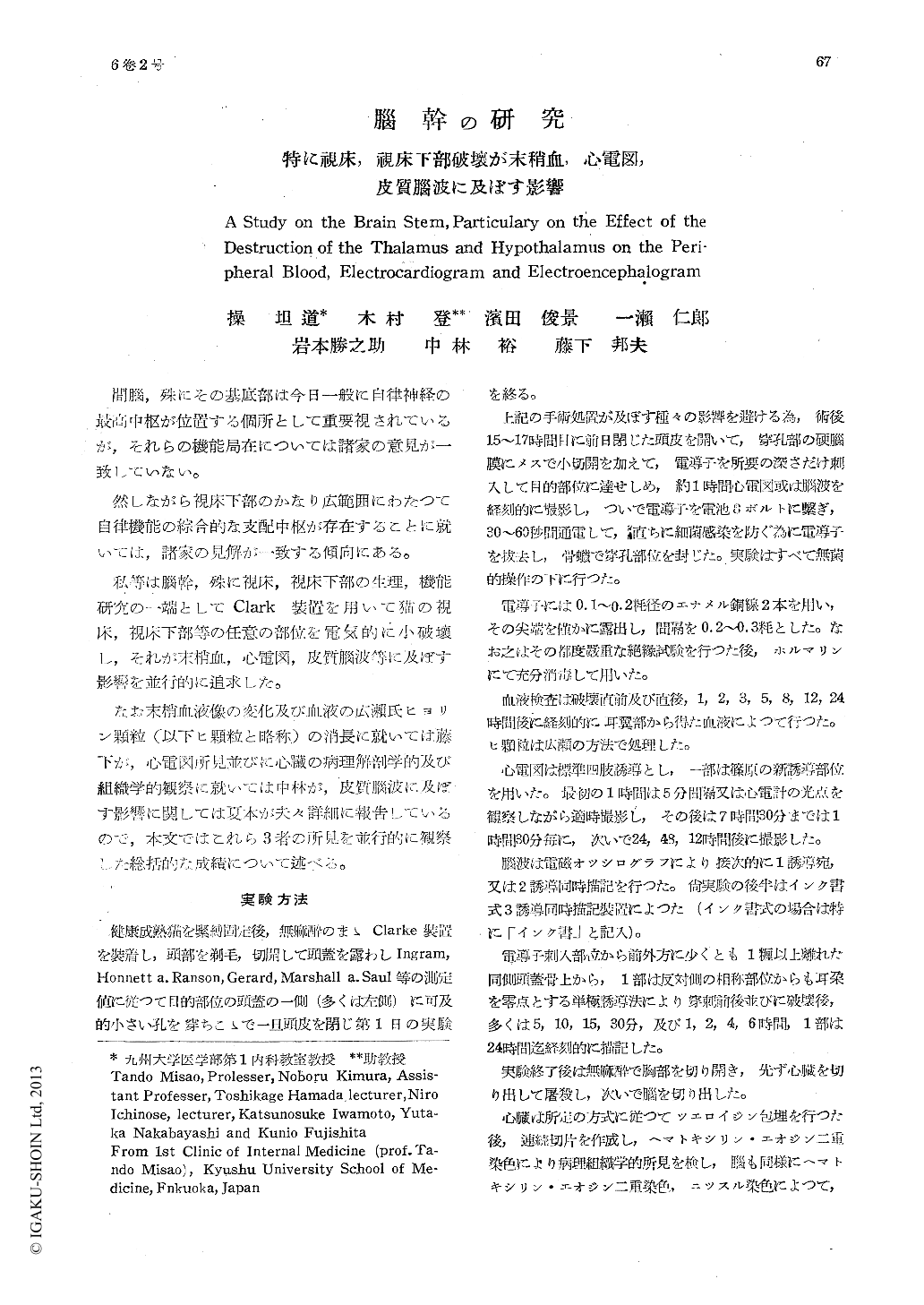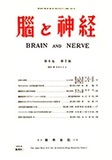Japanese
English
- 有料閲覧
- Abstract 文献概要
- 1ページ目 Look Inside
間腦,殊にその基底部は今日一般に自律神経の最高中枢が位置する個所として重要視されているが,それらの機能局在については諸家の意見が一致していない。
然しながら視床下部のかなり広範囲にわたつて自律機能の綜合的な支配中枢が存在することに就いては,諸家の見解が一致する傾向にある。
Experimental puncture and electrolytic des-truction of one side of the brain-stem were performed in the cat using Clarke's apparatus to see at regular intervals the effect on peri-pheral blood pictures, Hirose's cholin granules (HCG), electrocardiograms, electrocorticograms, etc., and the cat used was killed after each experiment for the patho-anatomical and histo-logical examination of the destroyed portion of the brain-stem and the heart. The results reached were as follows.
I. Effect on peripheral blood pictures and HCG.
(1) Destruction of N. ventralis, N. medialis and N.lateralis of the thalamus was followed by a slight increase of white blood cells and a decrease of HCG and that of N. posterior of the thalamus by a decrease of white blood cells and a marked increase of HCG. No marked change was noted in the number of red blood cells or the amount of hemoglobin.
(2) Internal hemorrhage of the lateral ventri-cle or of the 3rd ventricle and destruction of N. infundibularis posterior, and N. hypothala-micus lateralis had a general tendency to bring about a decrease of white blood cells and a marked increase of HCG. Destruction of N. hypothalamicus medialis tended to be followed by a slight increase of white blood cells and a decrease of HCG.
Ⅱ. Effect on electrocardiogram.
(1) Destruction of N.ventralis and N. medialis of the thalamus induced no observable change in heart beat, but that of N. posterior of the thalamus was followed by transitory brady-cardia.
(2) Internal hemmorrhage of the lateral ventricle and the 3rd ventricle, and destruction of the nuclei surrounding the 3rd ventricle were followed by a marked change in heart beat in all cases, with attendant tachycardia or bradycardia, various sorts of arrhythmia. Destruction of N. infundibularis posterior was also followed frequently by bradycardia though it was only transitory. Destruction of N. hypothalamicus medialis and N.hypothalamicus lateralis caused no observable change in heart beat.
(3) Some change, though rare and slight, in P and QRS was caused in some cases irrespec-tive of the presence or absence of the above changes in heart beat. An early change in ST and T, in T in particular, was observed in many cases. Such a change was varried in form, attended in a relatively greater number of cases by a reversion of T exclusively when there was a change in heart beat, bradycardia or tachycardia.
(4) Hemorrhage of the endocardium of the left ventricle was observed irrespective of the presence or absence of any change in heart beat in some cases. In such cases a decline and a change to the negative in ST and T were gradually promoted till the slaughter of the animalg.
Ⅲ. Effect on electrocorticograms.
(1) Destruction of N. medialis and N. lateralis of the thalamus was followed by a increase of fast waves and a decrease in period and ampli-tude, that of N. posterior of the thalamus by an increase in period and amplitude.
(2) Internal hemorrhage of the ventricle was followed by an increase of fast waves and a decrease in period and amplitude in two of three cases. Later there appeard spikes in one of these two cases. There was an increase in period and amplitude in the remaining one case. Destruction of N.hypothalamicus media-ns brought about an increase in fast waves and a decrease in period and amplitude in one of three cases. In one of the remaining two cases there was an appearance of spikes and slow waves, the spikes appearing with high frequency. In the remaining one case there was an increse in both period and amplitu-de.
In all these cases, however, other nuclei were also destroyed simultaneously so that the ef-fect of destruction of these other nuclei must be considered to have participated in the pro-duction of the above results.
Destruction of N. hypothalamicus lateralis induced an increase in period and amplitude.
Destruction of any nucleus of the thalamus and hypothalamus caused changes almost paral-lel with the foregoing in each nucleus in all cases, indicating that there is some functional difference between nuclei. The results reachad in relation to the hypothalamus were particular-ly like those obtained by Kurotsu and others in rabbits in which they classified the nuclei into the inmost (a), the intermediate (b) and the outmost (c).

Copyright © 1954, Igaku-Shoin Ltd. All rights reserved.


